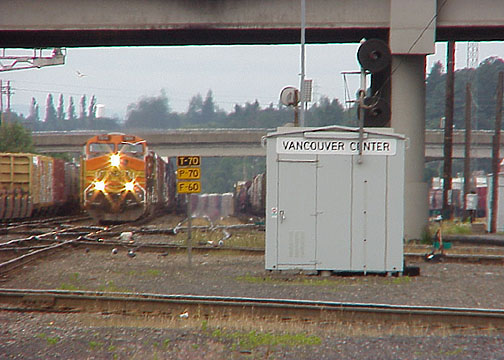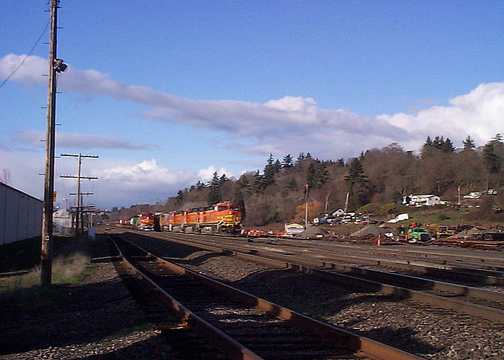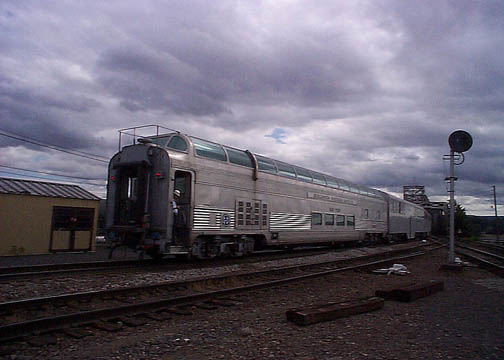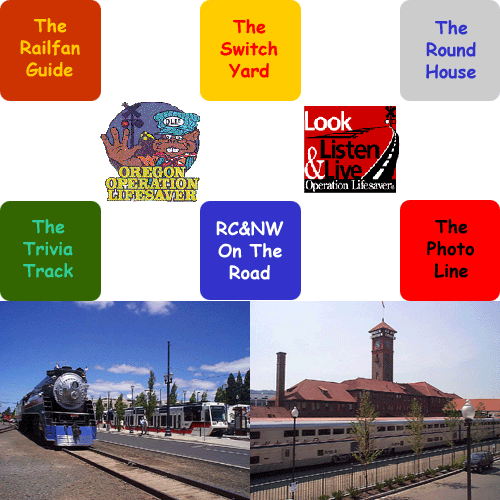 |
 |
|
The Vancouver, Wash. Amtrak station in January 2003. Its location "inside the wye" makes it one of the premier railfan spots in the Pacific Northwest. It was a true "Union Station", serving trains of the Northern Pacific, Great Northern, Union Pacific and Spokane, Portland & Seattle. |
 |
|
In years past, it witnessed the passage of the original Train of Tomorrow dome cars, then in GN/NP/UP pool passenger service between Portland and Seattle, and the "rainbow" streamliners of SP&S, carrying through cars of both NP's North Coast Limited and GN's Empire Builder, as well as cars in its own color scheme. It is currently served by six Cascades corridor trains, equipped with state-of-the-art TALGO equipment and older Horizon Fleet cars; the Chicago-Portland Empire Builder; and the Seattle-Los Angeles Coast Starlight, both equipped with bi-level Superliners. |
|
Vancouver, Wash., located about eight miles north of downtown Portland on the north bank of the Columbia River, is the hub of BNSF operations in the Portland metropolitan area. The city was not originally on the main north-south rail line between Portland and Seattle. That occurred in 1908, when the Northern Pacific bridged the Columbia to allow its trains and those of the new Spokane, Portland & Seattle to reach the Rose City on a direct, all-rail route. Previously, NP trains had operated up the west side of the river to a ferry crossing between Goble and Kalama. Today, the Portland-Goble segment of the old NP main is part of Portland & Western's Astoria line. From 1910 on, the NP main through Vancouver to Tacoma has also carried the trains of rival Union Pacific, as part of an agreement designed to halt significant territorial conflict between the two railroads. Great Northern and Milwaukee Road freights also used trackage rights on the route. |
 |
Vancouver Center is the interlocking at the heart of the yard complex north of the depot. The track in front of the control box is the lead to the Vancouver port complex, while the track immediately behind it is the Middle Lead that connects to the east-west Fallbridge Sub. |
|
In this telephoto shot from the depot platform, a southbound BNSF manifest is approaching the Mill Plain Blvd. overpass, which spans the south end of the yard. In the background is the Fourth Plain Blvd. bridge. Both offer good views and photo opportunities. |
|
The station area is easily accessible off Interstate 5. Northbound from Portland, you can take the City Center exit (use the second off-ramp north of the Interstate Bridge; the first ramp feeds into Wash. Hwy. 14 eastbound). After the exit ramp loops back over the freeway, turn left on either 6th St., 8th St. or 11th St. and follow the signs to the station. From I-5 southbound, take the exit for Mill Plain Blvd. and head west to Lincoln St. Turn left on Lincoln and follow it south to 11th St., then turn right to cross the tracks. There is ample free parking around the depot itself and along the long north-south platform. DO NOT park in the BNSF parking lot adjacent to the yard office, beyond the spur track that borders the east side of the station lot. This is railroad property and is patrolled by BNSF police units. The far north end of the main parking lot is also marked with No Trespassing signs. |
| Cascades #90251 is a former F40PH diesel, and gained a second lease on life when Amtrak rebuilt it as a cab car for the Pacific Northwest corridor. |  |
|
Unlike earlier F40PH conversions for other Amtrak regional trains, #90251 and its sisters in Cascades service originally had no baggage space in the carbody. Roll-up baggage doors were later added. It also wears a distinctive color scheme of green, creme and brown known locally as the "latte and creme in the woods". Here the car is trailing Cascades #500 as it makes its northbound stop at Vancouver just after 9:00 am. This same trainset, after arriving in Seattle at about 12:15 PM, will head back south after a short layover. |
|
To reach the Mill Plain and Fourth Plain overpasses, go east on 11th St., turn left onto Lincoln St. and head north. Lincoln St. crosses both boulevards, and the overpasses are just west of the intersections. Be aware that adjacent parking is extremely limited. At the far north end of the main yard, the 39th St. overpass is accessible for photography. It provides views of the main line, the main yard to the south and the "B" yard to the north. To reach 39th St. from the station, go east on 11th St., turn left onto Lincoln St. and go north. Turn left again at Fourth Plain Blvd., cross the overpass, then turn right at the traffic light (Fruit Valley Rd.). Follow this road to 39th St. (there is a convenience store at this intersection) and turn right. Parking near the overpass is also extremely limited. A small industrial complex north of 39th and west of the tracks provides some parking. DO NOT enter the yard complex to the south, or the smaller yard to the north of the street. |
 |
This was the view north from the 39th Street grade crossing before its replacement by an overpass. Two BNSF manifest freights wait for their highball in the "B" Yard at the north end of the complex. The track at the far right is the lead to the locomotive service area. |
|
To the east of the depot is the 8th Street junction, where the "Middle Lead" to Vancouver Yard, the Port of Vancouver and the Seattle Sub splits from the BNSF Fallbridge Sub to and from the Columbia River Gorge. Northbound trains routinely stop at the interlocking to change crews. You will also find westbound or northbound trains waiting here for dispatcher clearance to proceed. |
|
The east-west Fallbridge Sub forms the south leg of the wye, with the north-south Seattle Sub on the west leg. The north leg, the "Middle Lead", passes by the north side of the BNSF Vancouver Yard office. The main BNSF freight yard, which lies to the east of the north-south main, is the former SP&S yard; the smaller yard to the west of the main is the former NP yard. A small UP yard is also tucked away to the west of the old NP yard tracks. The small yard just north of 39th Street is known locally as the "B" yard. BNSF moved its Portland-area locomotive servicing to Vancouver in 1996 after it closed the Hoyt Street facility near Portland Union Station that same year. This complex, whose roundhouse was famous for the restoration of former SP "Daylight" 4-8-4 #4449 for the American Freedom Train in 1975, is now part of the extensive Pearl District redevelopment area. BNSF moved its old turntable to the new facility in Vancouver. |
| Union Pacific SD70M #4312 leads a Seattle-bound intermodal train off the Columbia River bridge and past the depot. It was one of UP's initial order of 1,000 widecab EMDs that the railroad used to update its motive power fleet after the merger with Southern Pacific in 1996. |  |
|
The tracks diverging to the left are the BNSF Fallbridge Sub to Wishram, Wash., which head east from Vancouver and up the north bank of the Columbia River. This is the former Spokane, Portland & Seattle main. The speed limit signs at the edge of the platform, from bottom to top, indicate a 30 mph speed for freight trains, conventional passenger trains and TALGOs in Cascades service. The TALGO sets, because of their tilting capability, are allowed higher speeds through many of the curves along the Seattle-Portland route. |
|
As the junction between two busy BNSF subdivisions, Vancouver sees almost the entire range of the railroad's freight traffic. Traffic levels vary during the week, with the largest volumes seen Tuesday-Saturday. Intermodal services include trains from Chicago to BNSF's Portland intermodal center. BNSF, which handles much of the container traffic out of the Ports of Seattle and Tacoma, has also increased the number of stack trains through Vancouver as these ports grow busier. Limitations on the number of trains using the former GN main line across Stevens Pass in north central Washington also provide a spike in movements through Vancouver when traffic increases. Daily manifest trains to and from Portland, Pasco, Longview, Tacoma and Seattle pass through, as do daily runs to and from California points. BNSF trains to and from California use the Fallbridge Sub to Avery, west of Wishram, where they cross the Columbia River and operate over the former Oregon Trunk route. Vancouver also sees a wide range of UP trains, including hot intermodal services; manifest trains to and from Hinkle, Ore., Longview, Wash. and North Platte, Neb.; and unit grain trains to and from the Port of Vancouver and Kalama, Wash. UP trains connect to and from the BNSF main at North Portland Junction and at Reservation interlocking in Tacoma. |
 |
BNSF, former ATSF Budd "Big Dome" lounge Bay View was built in 1954 and served on trains such as the Chief, El Capitan and San Francisco Chief. Santa Fe retained the car in 1971 when it sold most of its passenger rolling stock to Amtrak and Auto-Train. |
|
Since then, it has operated first as part of the ATSF executive train fleet and then in BNSF executive train service, where it has sometimes teamed with near sister Glacier View, a former GN Budd "Great Dome" lounge built in 1955 for the Empire Builder. Here, the Bay View brings up the rear of the BNSF Employee Appreciation Special at Vancouver on July 22, 2000. The train, led by the City of Portland's own former SP GS4 4-8-4 #4449, dropped its passengers here before crossing the Columbia River to turn on the wye at North Portland. |
|
BNSF power is a mix of both old and new, and provides a riot of color with BN Cascade green, Santa Fe blue and yellow, the classic Santa Fe "Warbonnet", and three different BNSF paint schemes: Heritage I (known as the "Pumpkin" scheme) on older units and some C44-9Ws; Heritage II, which incorporates the same orange and green from the Heritage I with design elements such as the old AT&SF 'cigar band" nose herald; and its latest with the Heritage II colors and the BNSF Railway "swoosh" logo. Union Pacific power is uniformly in its classic yellow and gray, and consists primarily of EMD and GE widecabs. A few former SP and C&NW units still show up in their old schemes, but these have become increasingly rare. Off-line locomotives showing up here include Canadian Pacific and Kansas City Southern units on UP unit bulk and manifest trains to and from the Eastport, Wash. border gateway with CPKC. Portland & Western (P&W) units show up on a daily manifest to and from Albany, Ore., a service the regional inherited from BNSF. P&W power is usually a mix of the railroad's ex-ATSF GP39-2s and units transferred in from other lines operated by P&W owner Genesee & Wyoming. CSX and Norfolk Southern units are also regular visitors. Canadian National units are sometimes found on potash trains entering the Port of Portland off the BNSF Seattle Sub. Montana Rail Link diesels often show up on BNSF Fallbridge Sub trains. More recent visitors have included TFM and Ferromex locomotives from Mexico operating on BNSF trains. Amtrak power is normally GE Genesis series P42s in the latest "wave" scheme on the Coast Starlight and the Empire Builder, and Siemens SC44 Chargers in the green, cream and brown Cascades scheme. Amtrak has also substituted P32s and P42s on the Cascades trains. The company's newest Siemens ALC-42 Chargers, a longer-distance variant of its SC44s, have also shown up on the Coast Starlight and the Empire Builder. |
| At the time of this photo in January 2003, this railroad-themed restaurant adjacent to the BNSF 8th St. interlocking in Vancouver was known as The Crossing. The core building had six rail cars added onto it, including former cars from CB&Q, GN, NP and SP&S, an NP caboose, and an SP&S boxcar. |  |
|
The building's second floor resembles a railroad interlocking tower. Crews removed the railroad cars in June 2006; a private owner purchased most of them and had them trucked to a nearby siding for storage. |
|
The convergence of several rail lines, the Columbia River crossing and the location of the passenger depot make Vancouver one of the premier railfan sites in the Northwest. However, the presence of so many trains, the large rail yard and the constraints imposed by the drawbridge also make this a significant choke point. BNSF continues to work with local commercial interests and with local and state governments to upgrade the rail lines through the Vancouver area to help eliminate or relieve some of the congestion. Among the proposed projects is a new Columbia River drawbridge, or the replacement of the existing swing span with a lift span. A new bypass along the eastern edge of the main yard allows through traffic to avoid fouling the Middle Lead and the north-south mains. BNSF and the Port of Vancouver built a bypass for trains entering and leaving the port area. The bypass leaves the Fallbridge Sub east of 8th Street, and allows trains to avoid the Middle Lead and the existing at-grade crossing of the Seattle Sub. BNSF also re-aligned the curve on the Fallbridge Sub past the east side of the depot. As part of this re-alignment, a new passenger platform was built to replace the previous one, which was removed as part of the project. As part of the railroad-wide project to add Positive Train Control signalling, the signals throughout the Vancouver rail complex were replaced. |
| To navigate through the site, just click on one of the links in our image map. | |
 |